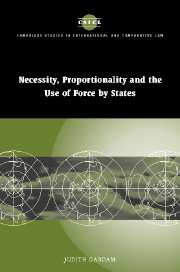Book contents
- Frontmatter
- Contents
- Foreword
- Preface
- Acknowledgments
- Table of cases
- List of abbreviations
- 1 The place of necessity and proportionality in restraints on the forceful actions of States
- 2 Necessity, proportionality and the forceful actions of States prior to the adoption of the United Nations Charter in 1945
- 3 Proportionality and combatants in modern international humanitarian law
- 4 Proportionality and civilians in modern international humanitarian law
- 5 Necessity, proportionality and the unilateral use of force in the era of the United Nations Charter
- 6 Necessity, proportionality and the United Nations system: collective actions involving the use of force
- Bibliography
- Index
- Cambridge Studies in International and Comparative Law
Foreword
Published online by Cambridge University Press: 16 July 2009
- Frontmatter
- Contents
- Foreword
- Preface
- Acknowledgments
- Table of cases
- List of abbreviations
- 1 The place of necessity and proportionality in restraints on the forceful actions of States
- 2 Necessity, proportionality and the forceful actions of States prior to the adoption of the United Nations Charter in 1945
- 3 Proportionality and combatants in modern international humanitarian law
- 4 Proportionality and civilians in modern international humanitarian law
- 5 Necessity, proportionality and the unilateral use of force in the era of the United Nations Charter
- 6 Necessity, proportionality and the United Nations system: collective actions involving the use of force
- Bibliography
- Index
- Cambridge Studies in International and Comparative Law
Summary
Those who regard the present as a period when the rules of international law concerning the use of force by States are specially contested are probably new to the field, or have short memories. They have always been contested. This has been so ever since the end of World War I when attempts began to be made to institute, or re-institute, constraints on resort to war. Whether they concerned Korea, Suez, Hungary, Cuba, the Congo, Czechoslovakia, Vietnam, Panama, Grenada, Nicaragua, Iraq or Yugoslavia (to cite some cases since 1945) debates over intervention, pre-emption and anticipatory self-defence have raged. Indeed, they have often seemed little more than a dialogue of the deaf.
Dr Gardam's aim is more restricted and may be correspondingly more determinate. In this well-informed study, she seeks to analyse the specific requirement of proportionality (and the related concept of necessity) as it relates both to the rules relating to the use of force and the rules of international humanitarian law restricting how force should be used in international and increasingly also in internal armed conflict. There is a considerable point to this inquiry. Even when the occasion for the use of force is controversial, as it so often is, the protagonists will assert that their action is limited to what is necessary and is proportionate, and this assertion will often be able to be tested against the facts in a way which does not depend on the underlying controversy about whether force should have been used at all.
- Type
- Chapter
- Information
- Necessity, Proportionality and the Use of Force by States , pp. xii - xivPublisher: Cambridge University PressPrint publication year: 2004

